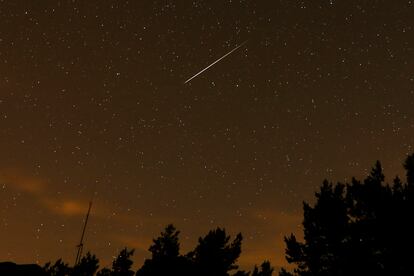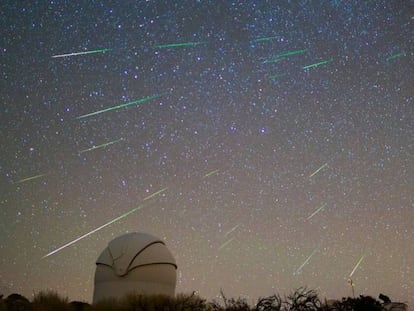Perseids 2023: how to watch the meteor shower this weekend
The best viewing will be from Saturday night into early Sunday morning, when viewers might be able to spot a meteor per minute

The annual Perseid meteor shower reaches its peak this weekend, sending bright trails of light streaking across the night sky.
With only a sliver of moon in the sky, conditions this year will be ideal for seeing lots of meteors.
“If you’ve got nice clear weather and a good dark sky, you go out just before dawn and you’ll see a Perseid per minute or so,” said NASA meteor scientist Bill Cooke. “That’s a pretty good show.”
Here’s how to watch the meteor shower:
What are the Perseids?
The Perseids — one of the biggest meteor showers we can see — occur every year in the late summer. Meteor showers happen when the Earth moves through fields of debris floating around in space. The Perseids come from comet Swift-Tuttle, a big ball of ice and rock that sheds pieces of dusty debris as it orbits around the sun. When the Earth passes by, those bits get caught in our atmosphere and burn up, creating the streaking lights. The Perseids get their name from the constellation Perseus, because the meteors’ paths appear to start out from this point in the sky.
When is the shower?
This year’s shower is already active, but the main event will be this weekend, when the shower reaches its peak from Saturday night into Sunday morning. Starting around 11 p.m. local time Saturday, a few meteors will start to show up — maybe one every 15 minutes, Cooke estimated. They’ll keep picking up the pace until before dawn on Sunday, when “you’ll see meteors appear all over the place,” he said.
How can I see them?
During this weekend’s peak, the moon will be a waning crescent — just a small slice in the sky. That’s good news because a bright moon can make it harder to spot the meteors. Last year, the moon was full during the peak. Anyone in the Northern Hemisphere will have a good view this year, as long as the sky is clear of light pollution and clouds. You don’t need any equipment to see them, but you will need to give your eyes around half an hour to adjust to the dark. Avoid looking at your cellphone since that can ruin your night vision.
The Perseids can appear anywhere in the sky. So just “lie on your back, look away from the moon and take in as much sky as you can,” Cooke said.
Sign up for our weekly newsletter to get more English-language news coverage from EL PAÍS USA Edition
Tu suscripción se está usando en otro dispositivo
¿Quieres añadir otro usuario a tu suscripción?
Si continúas leyendo en este dispositivo, no se podrá leer en el otro.
FlechaTu suscripción se está usando en otro dispositivo y solo puedes acceder a EL PAÍS desde un dispositivo a la vez.
Si quieres compartir tu cuenta, cambia tu suscripción a la modalidad Premium, así podrás añadir otro usuario. Cada uno accederá con su propia cuenta de email, lo que os permitirá personalizar vuestra experiencia en EL PAÍS.
¿Tienes una suscripción de empresa? Accede aquí para contratar más cuentas.
En el caso de no saber quién está usando tu cuenta, te recomendamos cambiar tu contraseña aquí.
Si decides continuar compartiendo tu cuenta, este mensaje se mostrará en tu dispositivo y en el de la otra persona que está usando tu cuenta de forma indefinida, afectando a tu experiencia de lectura. Puedes consultar aquí los términos y condiciones de la suscripción digital.
More information
Últimas noticias
Christmas loses its festive spirit: ICE fears cast shadow over religious celebrations
All the effects of gentrification in one corner of Mexico’s Colonia Roma
Palestinian reporter Youmna El Sayed: ‘My family told me I had to choose between being a journalist or a mother’
The new language of the workplace: Knowing how to ask AI questions is more important than using it
Most viewed
- The low-cost creative revolution: How technology is making art accessible to everyone
- Christian Louboutin: ‘Young people don’t want to be like their parents. And if their parents wear sneakers, they’re going to look for something else’
- US sanctions against jailed cartel leader ‘El Marro’ highlight Mexico’s lack of control over its prisons
- Liset Menéndez de la Prida, neuroscientist: ‘It’s not normal to constantly seek pleasure; it’s important to be bored, to be calm’
- Cartels in Mexico take a leap forward with narco-drones: ‘It is criminal groups that are leading the innovation race’










































